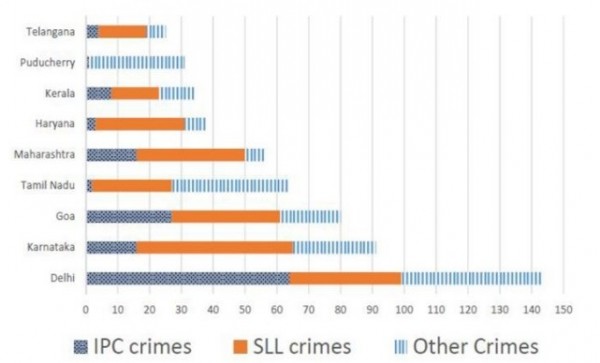The Ministry of Home Affairs is analysing crimes committed by foreigners in different states and union territories(UT) of India. All cases refer to the ones registered against foreigners in $2016$.
The number of cases-classified into three categories: IPC crimes, SLL crimes and other crimes-for nine states/UTs are shown in the figure below. These nine belong to the top ten states/UTs in terms of the total number of cases registered. The remaining state(among top ten) is West Bengal, where all the $520$ cases registered were SLL crimes.

The table below shows the ranks of the ten states/UTs mentioned above among ALL states/UTs of India in terms of the number of cases registered in each of the three category of crimes. A state/UT is given rank $r$ for a category of crimes if there are $(r-1)$states/UTs having a larger number of cases registered in that category of crimes. For example, if two states have the same number of cases in a category, and exactly three other states/UTs have larger numbers of cases registered in the same category, then both the states are given rank $4$ in that category. Missing ranks in the table denoted by *.
| |
IPC crimes |
SLL crimes |
Other crimes |
| Delhi |
* |
* |
* |
| Goa |
* |
4 |
* |
| Haryana |
8 |
6 |
* |
| Karnataka |
3 |
2 |
* |
| Kerala |
* |
9 |
* |
| Maharashtra |
3 |
4 |
8 |
| Puducherry |
13 |
29 |
* |
| Tamil Nadu |
11 |
7 |
* |
| Telangana |
6 |
9 |
8 |
| West Bengal |
17 |
* |
16 |
In the two states where the highest total number of cases are registered, the ratio of the total number of cases in IPC crimes to the total number in SLL crimes is closest to
- $1:9$
- $11:10$
- $3:2$
- $19:20$